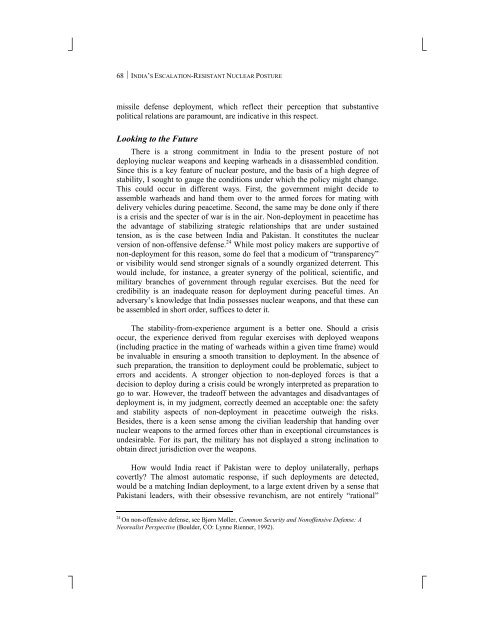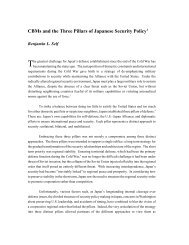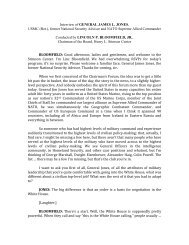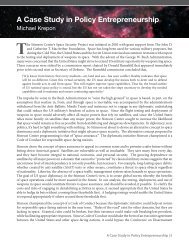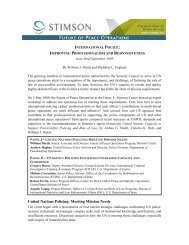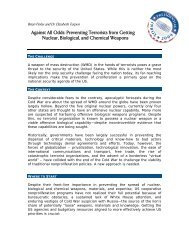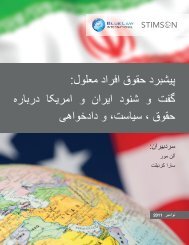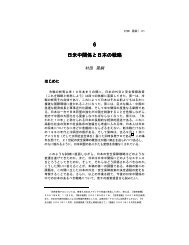India's Escalation-Resistant Nuclear Posture - The Stimson Center
India's Escalation-Resistant Nuclear Posture - The Stimson Center
India's Escalation-Resistant Nuclear Posture - The Stimson Center
Create successful ePaper yourself
Turn your PDF publications into a flip-book with our unique Google optimized e-Paper software.
⎦<br />
⎣<br />
68 ⏐ INDIA’S ESCALATION-RESISTANT NUCLEAR POSTURE<br />
missile defense deployment, which reflect their perception that substantive<br />
political relations are paramount, are indicative in this respect.<br />
Looking to the Future<br />
<strong>The</strong>re is a strong commitment in India to the present posture of not<br />
deploying nuclear weapons and keeping warheads in a disassembled condition.<br />
Since this is a key feature of nuclear posture, and the basis of a high degree of<br />
stability, I sought to gauge the conditions under which the policy might change.<br />
This could occur in different ways. First, the government might decide to<br />
assemble warheads and hand them over to the armed forces for mating with<br />
delivery vehicles during peacetime. Second, the same may be done only if there<br />
is a crisis and the specter of war is in the air. Non-deployment in peacetime has<br />
the advantage of stabilizing strategic relationships that are under sustained<br />
tension, as is the case between India and Pakistan. It constitutes the nuclear<br />
version of non-offensive defense. 24 While most policy makers are supportive of<br />
non-deployment for this reason, some do feel that a modicum of “transparency”<br />
or visibility would send stronger signals of a soundly organized deterrent. This<br />
would include, for instance, a greater synergy of the political, scientific, and<br />
military branches of government through regular exercises. But the need for<br />
credibility is an inadequate reason for deployment during peaceful times. An<br />
adversary’s knowledge that India possesses nuclear weapons, and that these can<br />
be assembled in short order, suffices to deter it.<br />
<strong>The</strong> stability-from-experience argument is a better one. Should a crisis<br />
occur, the experience derived from regular exercises with deployed weapons<br />
(including practice in the mating of warheads within a given time frame) would<br />
be invaluable in ensuring a smooth transition to deployment. In the absence of<br />
such preparation, the transition to deployment could be problematic, subject to<br />
errors and accidents. A stronger objection to non-deployed forces is that a<br />
decision to deploy during a crisis could be wrongly interpreted as preparation to<br />
go to war. However, the tradeoff between the advantages and disadvantages of<br />
deployment is, in my judgment, correctly deemed an acceptable one: the safety<br />
and stability aspects of non-deployment in peacetime outweigh the risks.<br />
Besides, there is a keen sense among the civilian leadership that handing over<br />
nuclear weapons to the armed forces other than in exceptional circumstances is<br />
undesirable. For its part, the military has not displayed a strong inclination to<br />
obtain direct jurisdiction over the weapons.<br />
How would India react if Pakistan were to deploy unilaterally, perhaps<br />
covertly? <strong>The</strong> almost automatic response, if such deployments are detected,<br />
would be a matching Indian deployment, to a large extent driven by a sense that<br />
Pakistani leaders, with their obsessive revanchism, are not entirely “rational”<br />
24<br />
On non-offensive defense, see Bjørn Møller, Common Security and Nonoffensive Defense: A<br />
Neorealist Perspective (Boulder, CO: Lynne Rienner, 1992).<br />
⎤<br />
⎡


